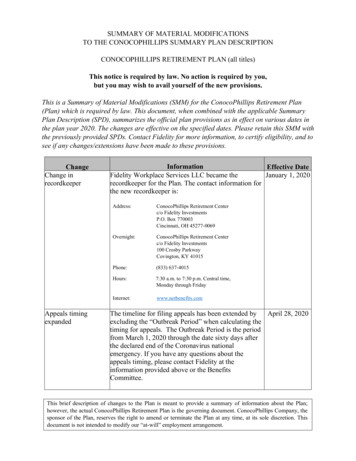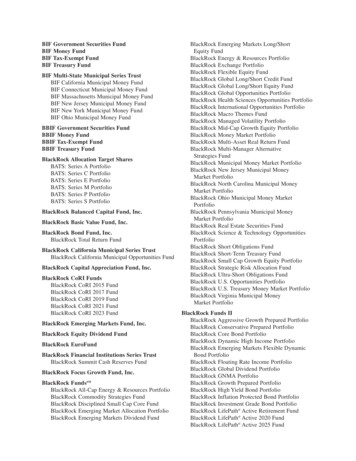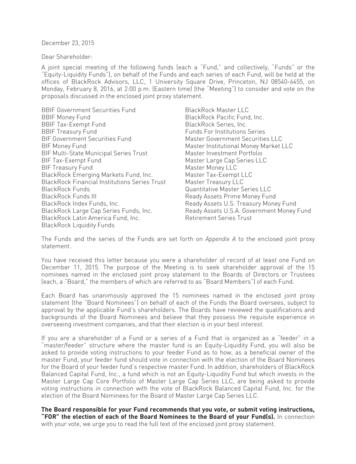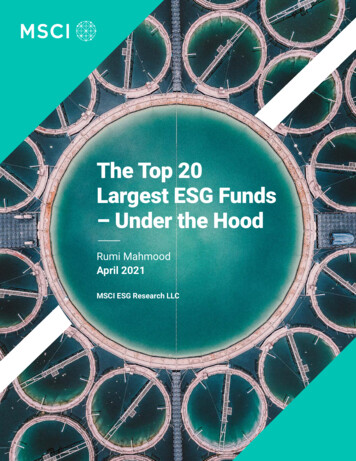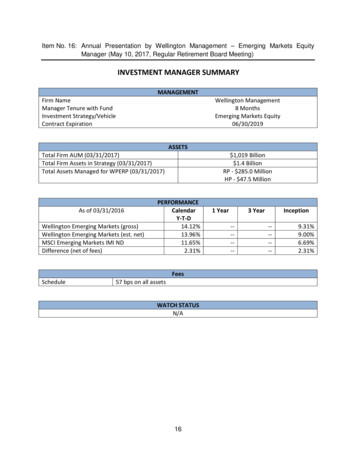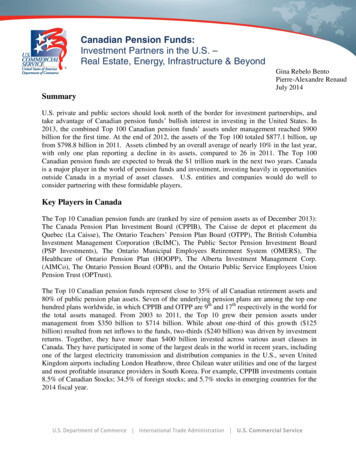
Transcription
Canadian Pension Funds:Investment Partners in the U.S. –Real Estate, Energy, Infrastructure & BeyondGina Rebelo BentoPierre-Alexandre RenaudJuly 2014SummaryU.S. private and public sectors should look north of the border for investment partnerships, andtake advantage of Canadian pension funds’ bullish interest in investing in the United States. In2013, the combined Top 100 Canadian pension funds’ assets under management reached 900billion for the first time. At the end of 2012, the assets of the Top 100 totaled 877.1 billion, upfrom 798.8 billion in 2011. Assets climbed by an overall average of nearly 10% in the last year,with only one plan reporting a decline in its assets, compared to 26 in 2011. The Top 100Canadian pension funds are expected to break the 1 trillion mark in the next two years. Canadais a major player in the world of pension funds and investment, investing heavily in opportunitiesoutside Canada in a myriad of asset classes. U.S. entities and companies would do well toconsider partnering with these formidable players.Key Players in CanadaThe Top 10 Canadian pension funds are (ranked by size of pension assets as of December 2013):The Canada Pension Plan Investment Board (CPPIB), The Caisse de depot et placement duQuebec (La Caisse), The Ontario Teachers’ Pension Plan Board (OTPP), The British ColumbiaInvestment Management Corporation (BcIMC), The Public Sector Pension Investment Board(PSP Investments), The Ontario Municipal Employees Retirement System (OMERS), TheHealthcare of Ontario Pension Plan (HOOPP), The Alberta Investment Management Corp.(AIMCo), The Ontario Pension Board (OPB), and the Ontario Public Service Employees UnionPension Trust (OPTrust).The Top 10 Canadian pension funds represent close to 35% of all Canadian retirement assets and80% of public pension plan assets. Seven of the underlying pension plans are among the top onehundred plans worldwide, in which CPPIB and OTPP are 9th and 17th respectively in the world forthe total assets managed. From 2003 to 2011, the Top 10 grew their pension assets undermanagement from 350 billion to 714 billion. While about one-third of this growth ( 125billion) resulted from net inflows to the funds, two-thirds ( 240 billion) was driven by investmentreturns. Together, they have more than 400 billion invested across various asset classes inCanada. They have participated in some of the largest deals in the world in recent years, includingone of the largest electricity transmission and distribution companies in the U.S., seven UnitedKingdom airports including London Heathrow, three Chilean water utilities and one of the largestand most profitable insurance providers in South Korea. For example, CPPIB investments contain8.5% of Canadian Stocks; 34.5% of foreign stocks; and 5.7% stocks in emerging countries for the2014 fiscal year.
Canadian Pension FundsCanada’s Rank on the World StageFrom: Towers Watson, P&I / TW 300 Analysis, Year End 2012, August 2013.The New Canadian Pension Fund Investment ModelThe Economist magazine referred to the Canada’s pension funds as “Maple Revolutionaries”.1Unlike any other pension fund, Canadians prefer to run their portfolios internally and investdirectly. In other words, they invest more money into buy-outs, infrastructure and property thanpublicly traded stocks and bonds. They believe that direct investment will produce higher returns;they are in some ways like “depoliticized sovereign-wealth funds”.2 OTTP has been using thisapproach since the 1990s. For the others, however, the economic crisis of 2008, the stockexchange markets instability and the limited credit offered by banks created a new wave of capitalneeds in many sectors. Canadian pension funds have thus shifted their portfolio and investmentfocus since 2007 to follow OTPP into direct investment.The new Canadian model has many advantages. In the midst of the great recession of 2008,companies including pension funds looked to find a way to cut expenses. By focusing on directinvestment, the Canadian model is cost saving because it eliminates the fees of intermediariescharging each transaction and each margin of profit on the stock and bond market. Moreover, theCanadian pension funds feel less pressure to chase the high returns, which enables them to pursue1"Maple Revolutionaries: Canada's Pension Funds." Economist (US) 3 Mar. 2012. Web. 20 June 2014. http://www.economist.com/node/21548970 .2Maple Revolutionaries: Canada's Pension Funds." Economist (US) 3 Mar. 2012. Web. 20 June 2014. http://www.economist.com/node/21548970 .2
Canadian Pension Fundsinvestments with less risk and leverage. Over the past ten years, OTPP had the highest totalreturns of the biggest 330 public and private pension in the world.The Melbourne Mercer Global Pension Index, widely considered as the premier internationalranking of retirement income systems, has found Canada’s to be among the strongest in the world.The Index tracks more than forty indicators of system health in such areas as integrity, adequacyand sustainability. In 2012, Canada ranked sixth out of eighteen countries – ahead of the UnitedKingdom, the United States, Germany, France and Japan, among others.From: Melbourne Mercer Global Pension Index, October 2013 – 5th EditionCanadian Pension Fund Investments in the U.S. and InternationallyInvesting in Canada is a priority; however Canadian pension funds have invested all around theworld since 2007. Just CPPIB alone has 197 worldwide partnerships in 33 countries, resulting in103 transactions for the 2014 fiscal year. Some of the major investments for the past three yearsin the United States and the rest of the world are listed below:Investments in the United States CPPIB and PSP Investments acquired Kinetic Concepts, an American medical devicescompany based in San Antonio (TX), for 6.1 billion in 2011. CPPIB tripled its investment in 2011 in the internet phone service Skype in an 8.5 billiondeal with Microsoft, taking home 933 million on an initial 300 investment.3
Canadian Pension Funds OMERS has 10billion invested in the United States, both public and private markets. In October 2011, OMERS became one of Canada’s largest venture capital investors withOMERS Venture, a 180 million fund that will focus on North American technology, media,telecommunications, clean technology and life sciences. In November 2011, La Caisse announced an 850 million deal to buy ConocoPhillips’16.55% stake in Colonial Pipeline Co, the largest refined petroleum products pipeline in theUnited States. CPPIB invested 2 billion, representing a 45% interest, in 10 regional malls, primarily inCalifornia, and two redevelopment sites (2012). CPPIB, with a partnership with Ares Management LLC, bought U.S. luxury retailer NeimanMarcus Group Ltd. and its 79 stores for 6 billion in September 2013. OTPP invested 500 million in Hudson’s Bay Co.’s 2.9 billion purchase of Saks FifthAvenue in New York City in July 2013. OTPP bought Impark, which leases or manages more than 2,000 parking locations, consistingof more than 400,000 parking spaces in more than 25 markets in Canada and in the U.S. La Caisse total assets geographic diversification is represented by 56.2% in Canada; 19.7% inthe U.S. and 9.7% for the Euro zone. Recent major investments in the U.S. include:- January 2013: 500 million investment in a portfolio of 13 Invenergy wind farms in Canada(2) and in the United States (11);- April 2013: Investment in the 1.5 billion equity residential portfolio recently taken privateby Goldman, Sachs & Co. and real estate manager Greystar Real Estate Partners;- June 2013: Acquisition of the 47-story Wells Fargo Center in Seattle for 390 million;- October 2013: Acquisition with an affiliate of Beacon Capital Partners of a 51% managingmember interest in 1211 Avenue of the Americas in NYC valued at more than 850 million;- October 2013: 370 million investment in the 10 and 120 South Riverside Plaza officebuildings in Chicago, IL. - November 2013: Joint venture MWest, backed by DivcoWest, Ivanhoé Cambridge and TPGReal Estate added 825,000 square feet to its Silicon Valley Portfolio;- June 2014: Opening of an office in Washington D.C. to expand its U.S. & global presence;- July 2014: Acquisition of a 24.7 % ownership stake in Invenergy based in Chicago;- August 2014: In a partnership with Veritas Investments Inc., it will acquire multiresidentialproperties in San Francisco.In July 2013, OMERS in partnership with a Japanese pension fund, acquired 50% stake for 2billion in the Midland Cogeneration Venture in Midland, MI, a gas-fired thermal power plant.CPPIB bought the insurance business Wilton Re Holdings Limited (Wilton, CT) for 1.8billion in March 2014.Investments Around the World4
Canadian Pension Funds OTPP invested 541 million in two Chilean water utilities in 2011. Also in November 2011, AIMCo bought 50% stake in Chile’s second-largest electricitydistributor, Grupo Saesa, from Morgan Stanley Infrastructure Partners. CPPIB 50% stake in the Commonwealth Property Office Fund includes 21 office buildings inAustralia, valued to 3.3 billion, acquired in 2013. 27.6% stake in Aliansce Shopping Center, one of Brazil’s largest shopping mall developers. A 15% stake in ORPEA S.A., based in Paris, France, Europe’ largest supplier of nursing care. Many real estate investment in the UK including: 23.15% stake in 6 airports ( with LondonHeathrow), office buildings in London ( 200 million), and shopping malls in Birmingham( 400 million). New CPPIB investments include real estate partnerships in India valued to 450 million fornew residential projects in Mumbai. CPPIB 36.5% stake in the major transporter of natural gas in Peru, Transportada de Gas delPeru, valued to 807 million. Real estate partnerships in South Korea and China valued to 400 million.Canada’s Economic EnvironmentCanada’s financial system has been described as strong and stable by many economists andspecialists. Not only have the Canadian pension funds outperformed most internationalcompetitors, but the Canadian banks have also faired very well in spite of the economic crisis.The top 5 banks in Canada3 have reported profits of 29.4 billion for the 2014 fiscal year, up ahealthy 5% from last year despite the weak economy, slower consumer lending and othereconomic issues. Four of these banks are also in the Top 10 of the strongest banks in the worldaccording to Bloomberg Market Magazine.4 The stability of the financial structure in Canada isvery solid, based on an important capital inflow, and it is projected to continue its growth formany years to come.For More InformationGina BentoCommercial SpecialistU.S. Consulate MontrealU.S. Department of Commerce International Trade & Investment Administration(514) 908-3660; gina.bento@trade.govThe U.S. Commercial Service — Your Global Business Partner3The top 5 Canadian banks are: Royal Bank of Canada (RBC), Toronto-Dominion Bank (TD Canada Trust), Bank ofNova Scotia (Scotiabank), Bank of Montreal (BMO), and Canadian Imperial Bank of Commerce (CIBC).4According to data compiled by Bloomberg Markets magazine; CIBC, Royal Bank, Scotiabank and TD were ranked3rd, 4th, 7th and 8th, respectively, on the publication’s annual ranking of the world’s strongest and safest lenders asof May 2013.5
Canadian Pension FundsWith its network of offices across the United States and in more than 80 countries, the U.S.Commercial Service of the U.S. Department of Commerce utilizes its global presence andinternational marketing expertise to help U.S. companies sell their products and servicesworldwide. Locate the U.S. Commercial Service trade specialist in the U.S. nearest you byvisiting http://www.export.gov/eac.Comments and Suggestions: We welcome your comments and suggestions regarding thismarket research. You can e-mail us your comments/suggestions to:Customer.Care@mail.doc.gov. Please include the name of the applicable market research inyour e-mail. We greatly appreciate your feedback.Disclaimer: The information provided in this report is intended to be of assistance to U.S. exporters. While we make every effort to ensure itsaccuracy, neither the United States government nor any of its employees make any representation as to the accuracy or completeness ofinformation in this or any other United States government document. Readers are advised to independently verify any information prior toreliance thereon. The information provided in this report does not constitute legal advice. The Commercial Service reference to or inclusion ofmaterial by a non-U.S. Government entity in this document is for informational purposes only and does not constitute an endorsement by theCommercial Service of the entity, its materials, or its products or servicesInternational copyright, U.S. Department of Commerce, 2014. All rights reserved outside of the United States6
80% of public pension plan assets. Seven of the underlying pension plans are among the top one hundred plans worldwide, in which CPPIB and OTPP are 9 th and 17 th respectively in the world for the total assets managed. From 2003 to 2011, the Top 10 grew their pension assets under management from 350 billion to 714 billion.


